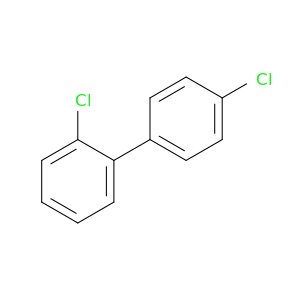
2,4'-DICHLOROBIPHENYL
| Title | Journal |
|---|---|
| Detection and measurement of the agonistic activities of PCBs and mono-hydroxylated PCBs to the constitutive androstane receptor using a recombinant yeast assay. | Toxicology in vitro : an international journal published in association with BIBRA 20151001 |
| Binding interactions of hydroxylated polychlorinated biphenyls (OHPCBs) with human hydroxysteroid sulfotransferase hSULT2A1. | Chemico-biological interactions 20140405 |
| Screening of 397 chemicals and development of a quantitative structure--activity relationship model for androgen receptor antagonism. | Chemical research in toxicology 20080401 |
| Temperature-dependent biotransformation of 2,4'-dichlorobiphenyl by psychrotolerant Hydrogenophaga strain IA3-A: higher temperatures prevent excess accumulation of problematic meta-cleavage products. | Letters in applied microbiology 20070401 |
| Growth of the genetically engineered strain Cupriavidus necator RW112 with chlorobenzoates and technical chlorobiphenyls. | Microbiology (Reading, England) 20070101 |
| Prediction of estrogen receptor agonists and characterization of associated molecular descriptors by statistical learning methods. | Journal of molecular graphics & modelling 20061101 |
| Cometabolic degradation of polychlorinated biphenyls at low temperature by psychrotolerant bacterium Hydrogenophaga sp. IA3-A. | Current microbiology 20060701 |
| Isolation and characterization of a biphenyl-utilizing psychrotrophic bacterium, Hydrogenophaga taeniospiralis IA3-A, that cometabolize dichlorobiphenyls and polychlorinated biphenyl congeners in Aroclor 1221. | Journal of basic microbiology 20060101 |
| Impact of induced fit on ligand binding to the androgen receptor: a multidimensional QSAR study to predict endocrine-disrupting effects of environmental chemicals. | Journal of medicinal chemistry 20050908 |
| [Surface chemical behavior of 2,4-dichlorophenol in presence of metal oxides]. | Ying yong sheng tai xue bao = The journal of applied ecology 20050401 |
| Sorption of 2,4'-dichlorobiphenyl and fluoranthene to a marine sediment amended with different types of black carbon. | Environmental toxicology and chemistry 20041101 |
| Retention indexes for temperature-programmed gas chromatography of polychlorinated biphenyls. | Analytical chemistry 20040915 |
| Ortho-substituted but not coplanar PCBs rapidly kill cerebellar granule cells. | Toxicological sciences : an official journal of the Society of Toxicology 20040501 |
| Study of 202 natural, synthetic, and environmental chemicals for binding to the androgen receptor. | Chemical research in toxicology 20031001 |